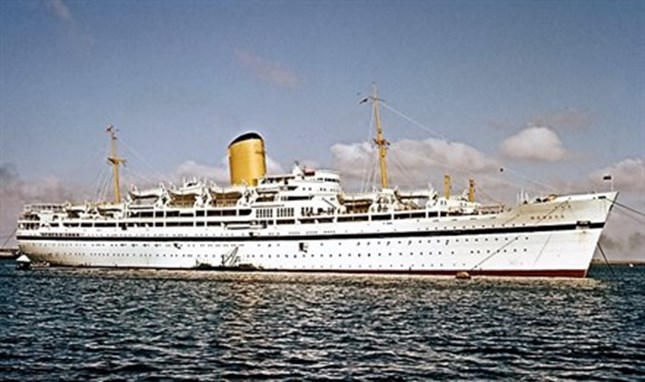Terry Hoyle tells us that until 1961, his only connection with the armed services was one grandfather who fought in the trenches, the other who built battleships and his dad, who was a “tankie” in Algeria, Tunisia, Italy and Austria; Terry recollects "dad was a Legion member and I guess I joined in his memory. True, my grandmothers did their bit with one working with the wounded in Devonport and the other doping aeroplanes at Graham White Aviation in Hendon. Mum was strafed by a low flying but damaged Dornier once but luckily survived the experience; the Dornier crashed soon after, served it right!"
As for me, then still a teenager, I joined HMT “Nevasa” in Southampton in 1961, as one of her Radio Officers. “Nevasa” was a purpose built “trooper” run by the British India Steamship Navigation Company (BI). As far as my friends back home were concerned, I was aboard Her Majesty’s Troopship; actually, HMT stood for “Hired Merchant Transport"!

One of the many things I experienced as a young lad at sea in her was a moving (in more ways than one) massed-band concert at the northern entrance to the Suez Canal. We were on the last voyage of “Nevasa” as a troopship, heading back to the UK with Army and a few RAF personnel from Aden; our sister ship, “Oxfordshire”, managed by Bibby Line, was also on her last trooping trip but she was outward bound. She was waiting to join the south-bound canal convoy at Port Said; we were passing by in the other direction.
We always seemed to be carrying a band aboard, Regimental or otherwise, who practised and performed during our regular voyages from Southampton to Hong Kong, via Gibraltar, Malta, Cyprus, Aden, Colombo, Penang and Singapore and back, this trip was no exception. However I believe on this occasion “Oxfordshire” had three.
Our Captain, BI’s Commodore Reggie Bond, was always “up” for a bit of fun, providing it met the then rules of decorum applicable to his position, and the ships compliment (and didn’t frighten his parrot). Short range radiotelephony was in its infancy aboard merchant vessels at that time but we did have a large box of tricks on the bridge known as a Marconi “Argonaut”. This allowed our navigators to communicate directly with their opposite numbers aboard “Oxfordshire” by VHF radio. Arrangements were then made aboard both ships by commands being relayed below by hard-wired telephone, and human runner!
It was dusk if memory serves when the brightly lit ships passed within a cable’s length of each other with all four bands playing in perfect harmony and more than two thousand people lining the ship’s respective rails and singing “Land of Hope and Glory” in unison. Tingle factor stuff or what? Eat your heart out “Last Night”…
After depositing our passengers in Southampton, to more pomp and circumstance due to a mighty vessel completing her final mission, we sailed for The Fal in Cornwall, laying the old girl up by King Harry Ferry. She had succumbed to the changing moods of government, the abolition of National Service and the age of the aeroplane."